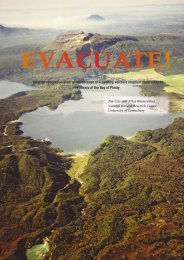Volcanoes - Ministry of Civil Defence and Emergency Management
Volcanoes - Ministry of Civil Defence and Emergency Management
Volcanoes - Ministry of Civil Defence and Emergency Management
Create successful ePaper yourself
Turn your PDF publications into a flip-book with our unique Google optimized e-Paper software.
Our research at Massey University has been<br />
focused on underst<strong>and</strong>ing the details <strong>of</strong> the past<br />
volcanic history <strong>of</strong> these volcanoes. It comes as no<br />
surprise that this record <strong>of</strong> volcanic activity is far more<br />
detailed <strong>and</strong> complex than we ever envisaged when we<br />
began. For example, our results show that Taranaki/<br />
Egmont volcano has been actively spreading ash<br />
across the Taranaki region for over 130,000 years. The<br />
important positive spin-<strong>of</strong>f <strong>of</strong> this activity is <strong>of</strong> course<br />
the premier soils <strong>of</strong> the region that the dairy industry<br />
takes advantage <strong>of</strong> today. Whilst there is no activity to<br />
be seen in the crater today, this does not mean that Mt.<br />
Taranaki/Egmont is extinct; it is only a matter <strong>of</strong> time<br />
before it will erupt once more.<br />
Our research has led to information on what<br />
might happen in future eruptions from Ruapehu,<br />
Taranaki/Egmont <strong>and</strong> Tongariro volcanoes <strong>and</strong> how<br />
these effects might be mitigated. Some <strong>of</strong> these results<br />
are described in the civil defence information booklets<br />
produced by the <strong>Ministry</strong> <strong>of</strong> <strong>Civil</strong> <strong>Defence</strong> & <strong>Emergency</strong><br />
<strong>Management</strong> for community-wide distribution by local<br />
authorities. Information from student <strong>and</strong> staff research<br />
supported by the Public Good Science Fund have<br />
resulted in a lahar hazards map for Ruapehu (Fig. 1;<br />
also available at http://<br />
soils/earth.massey.ac.nz),<br />
<strong>and</strong> a volcanic hazards<br />
map for Taranaki (Fig. 2).<br />
These are based on the<br />
mapping <strong>and</strong> dating<br />
<strong>of</strong> all the historic <strong>and</strong><br />
prehistoric lahar <strong>and</strong><br />
other mass-flow deposits at both volcanoes, <strong>and</strong><br />
determining their frequency for a large number <strong>of</strong> sites.<br />
NEW SIX-YEAR RESEARCH PHASE<br />
The Massey-based research team are about to<br />
begin a new six-year phase <strong>of</strong> research into the risks<br />
<strong>of</strong> our mountain volcanoes, funded by the Foundation<br />
for Research Science <strong>and</strong> Technology. This work will<br />
involve a number <strong>of</strong> different ways <strong>of</strong> improving our<br />
underst<strong>and</strong>ing <strong>of</strong> the volcanic risk posed by the main<br />
<strong>and</strong>esitic mountain-building volcanoes.<br />
By looking closely at the record <strong>of</strong> the last 1000-<br />
2000 years <strong>of</strong> eruptions at Ruapehu, Egmont/Taranaki<br />
<strong>and</strong> Tongariro, we have the best chance to find out<br />
the detailed factors controlling the rise <strong>and</strong> eruption <strong>of</strong><br />
magmas at <strong>and</strong>esite volcanoes. Over this geologically<br />
brief time-range, a wide range <strong>of</strong> different events with<br />
strong differences in explosivity <strong>and</strong> hazard potential<br />
occurred. We want to find<br />
out why our volcanoes<br />
behave in this seemingly<br />
irregular fashion. The<br />
answers will be found by<br />
examining the physical <strong>and</strong><br />
chemical properties <strong>of</strong> the<br />
deposits from these recent<br />
eruptions with a range <strong>of</strong><br />
microscopic <strong>and</strong> analytical<br />
techniques. For this research<br />
we will work with research<br />
colleagues at the Universities<br />
<strong>of</strong> Auckl<strong>and</strong> <strong>and</strong> Waikato<br />
in New Zeal<strong>and</strong> <strong>and</strong> the<br />
University <strong>of</strong> Oregon in the<br />
United States. If we can<br />
underst<strong>and</strong> these eruption<br />
drivers, perhaps we can<br />
also develop tests that could<br />
be used on ejecta at the<br />
beginning <strong>of</strong> eruptions to give<br />
rapid forecasts <strong>of</strong> what might<br />
happen next.<br />
We want to find out why our volcanoes behave<br />
in this seemingly irregular fashion. If we can<br />
underst<strong>and</strong> these eruption drivers, perhaps<br />
we can also develop tests that could be used<br />
on ejecta at the beginning <strong>of</strong> eruptions to give<br />
rapid forecasts <strong>of</strong> what might happen next.<br />
Towering over the Gr<strong>and</strong> Chateau on 18 June 1996 is one <strong>of</strong> the<br />
smaller ash plumes produced during the 1995-96 activity <strong>of</strong> Ruapehu.<br />
This eruptive episode, which lasted nearly 18 months spread<br />
volcanic ash over much <strong>of</strong> the central North Isl<strong>and</strong>, reaching as far as<br />
Auckl<strong>and</strong> at times.<br />
We know already that<br />
the geology <strong>of</strong> our mountain<br />
volcanoes <strong>and</strong> their surrounds<br />
are dominated by the deposits<br />
<strong>of</strong> mass flows, including muddy<br />
flood-like “lahars”, large l<strong>and</strong>slides<br />
<strong>of</strong> entire mountain flanks in<br />
“debris avalanches” <strong>and</strong> rapidly<br />
moving clouds <strong>of</strong> superheated gas <strong>and</strong> particles called<br />
“pyroclastic flows”. All <strong>of</strong> these flow types have the<br />
potential to travel great distances from a volcano within<br />
minutes or hours. Their high speeds <strong>and</strong> intense<br />
destructive power make them the most hazardous to<br />
life <strong>of</strong> all volcanic processes. We want to find out how<br />
these flows are generated, how far <strong>and</strong> how fast will<br />
they travel if they happened tomorrow <strong>and</strong> where<br />
would they flow? The answers to these questions<br />
will be found by collecting new information on the<br />
characteristics <strong>of</strong> past mass-flow deposits <strong>and</strong> integrating<br />
these data into novel methods <strong>of</strong> numerical (computerdriven)<br />
simulations <strong>and</strong> models. By collaborating with<br />
researchers at the University <strong>of</strong> Buffalo in the United<br />
States, we can apply sophisticated computer modelling<br />
<strong>of</strong> different types <strong>of</strong> flows over so-called “digital<br />
elevation models” <strong>of</strong> the present day terrain. In this way<br />
our next generation <strong>of</strong> hazard maps will have more <strong>of</strong><br />
a “forecasting” approach. Coupled with the computer<br />
modelling, we will also work with colleagues at the<br />
University <strong>of</strong> Kiel (Germany) to use laboratory-scale<br />
Lahar flowing at Tangiwai on 25 September 1995,<br />
during a day <strong>of</strong> lahars formed by the explosive<br />
emptying <strong>of</strong> water from Ruapehuʼs Crater Lake.<br />
At this time, the lahar contained about 40% by<br />
volume sediment!<br />
experiments for underst<strong>and</strong>ing more about the physics<br />
27<br />
TEPHRA<br />
June 2004

















